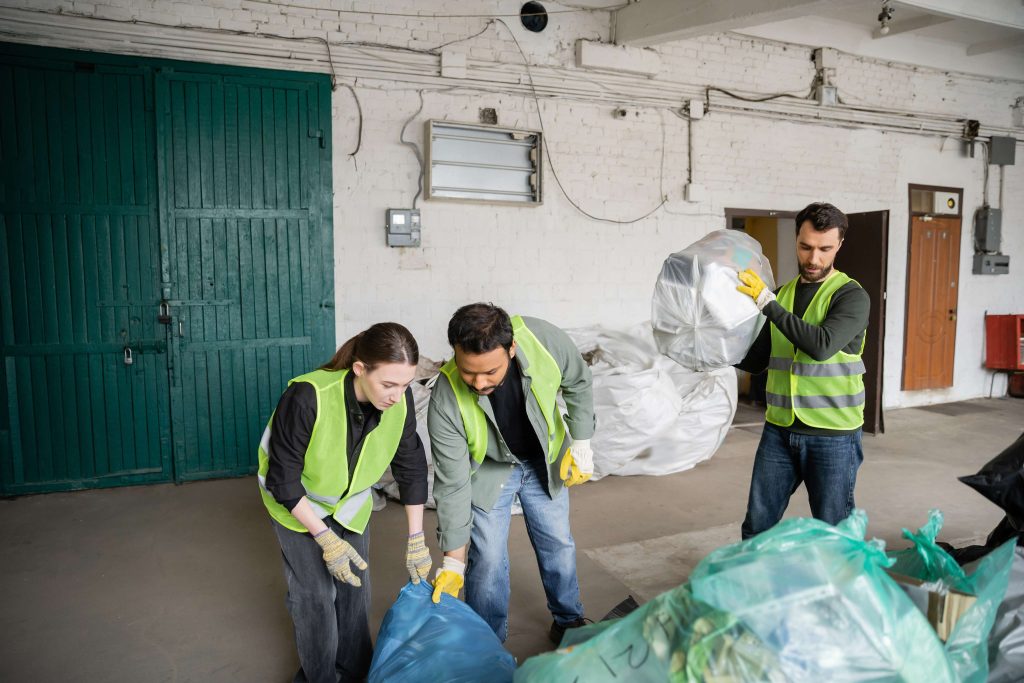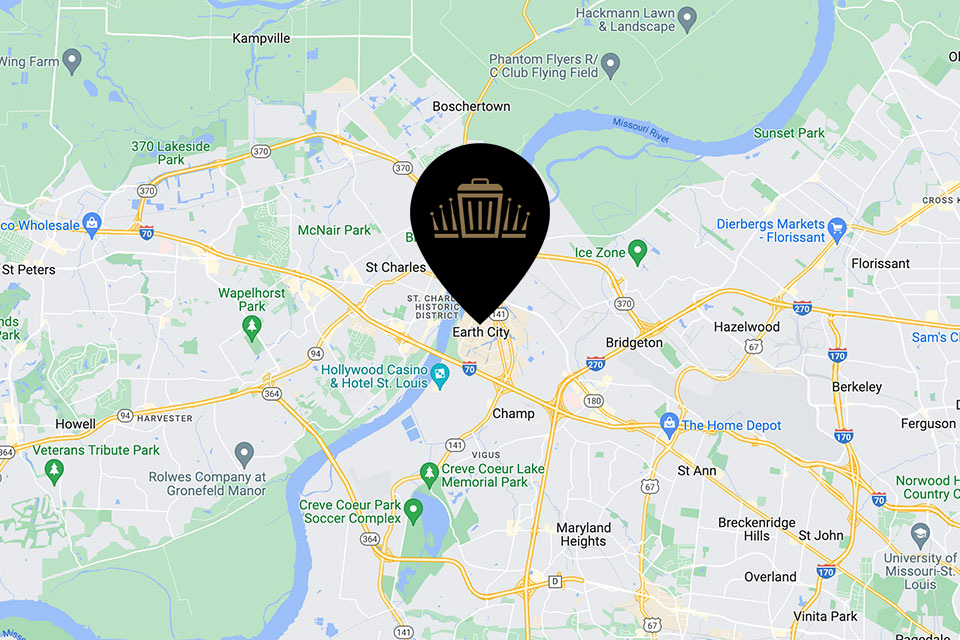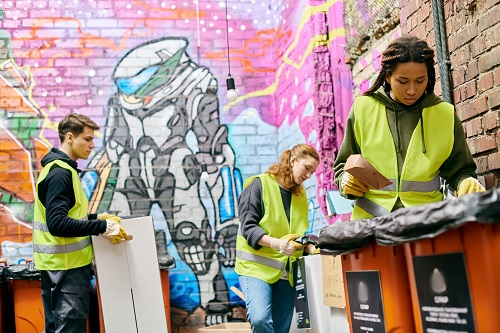Warehouse Cleanout Services
Warehouse and factory cleanouts are about getting old stock, scrap, broken machines and junk out of work spaces. A lot of companies do this to clear space, satisfy safety regulations or prepare for new equipment.It requires organizing, relocation, and secure disposal of garbage. Warehouse and factory cleanouts are in order! To demonstrate the complete process, the below sections describe what occurs and how teams manage each phase.
GET A FREE ESTIMATE
What will it cost for us to remove your junk and take it to a disposal site? We would love to provide you with an approximation of the final price. All you have to do is give us some information about the cleanout or demolition project you have in mind. Please fill out the nearby form.
The Strategic Imperative
Frequent warehouse and factory cleanouts are more than just routine maintenance. They are essential to maintaining operational flow, safety, and regulatory compliance. Cleanouts allow companies to stay ahead of problems, save money, and build a culture of safety and responsibility. They advocate intelligent use of space and resources, which is essential in any business that’s moving at supersonic speed.

Operational Flow
Cleanouts clear aisles and workspaces, preventing clutter from impeding work. A clean warehouse simplifies the process of transporting merchandise, with less risk of tripping over something or spending extra minutes digging through boxes. This habit facilitates a simplified workflow, accelerates picking, and assists shipments in getting out the door on time.
Neat environments assist teams comprehend inventory more effectively, minimize mistakes and minimize the chance of goods being misplaced or destroyed. Periodic cleanouts ensure tools and equipment are always accessible, which keeps production humming. With quarterly cleanouts, companies can bypass the bottlenecks that prevent orders from being shipped.
Safety Culture
Eliminating hazards in cleanouts keeps us all safe at work. Cleanouts are an opportunity to identify and eliminate broken pallets, spilled materials, or blocked exits that could potentially lead to injuries. Doing the right thing when it comes to hazardous disposal is important for worker safety and environmental health.
Scheduled cleanouts promote a strategic safety mindset. They become the habit, not just a response to issues. When employees observe that safety is valued, they take ownership and are more inclined to maintain their immediate work areas free. This creates a culture of everyone looking out for everyone else.
Space Optimization
Unused items and junk occupy space. Cleanouts assist you in reclaiming these spaces and create space for new machinery or stock. In a warehouse, space is currency. Unobstructed aisles and labeled racks signify speed and reduced errors.
Post-cleanout, teams can rethink their storage schemes. For instance, using vertical racks or grouping items by frequency of use can increase efficiency. When space is optimized, warehouses can scale their efficiency of storage by three times over time.
Regulatory Adherence
Staying compliant with local regulations is a given in warehouse management. Cleanouts ensure that waste and junk are disposed of the right way, lowering legal risks and issues with fines. Regular inspections during cleanouts identify compliance gaps before they turn into larger problems.
Recording cleanouts is important too. Documentation aids audits and demonstrates a willingness to comply. This cautious tactic enables companies to skirt fines and cultivate credibility with regulators and customers.
Asset Recovery
Cleanouts can find assets of value. Unwanted items can be repurposed, sold, or donated. This minimizes waste and in some cases even returns money.
Sifting through dead stock does a great job at keeping the warehouse clean and current. Knowing what is recovered or repurposed helps to better inventory management. It’s strategically imperative to give away what you can use because it’s sustainable and good PR with both the public and employees.
The Cleanout Blueprint
A warehouse or factory cleanout demands a crisp blueprint. Each round, from start to finish, should operate on a fixed schedule. Engaging the appropriate parties early assists in satisfying everyone’s requirements. Safety has to be front and center every day with rules for every task.
Planning
A checklist is the backbone of any warehouse cleanout. It begins with a walk-through to observe what must go and what can remain. Add sorting, packing, moving, disposal, and cleaning phases with annotations on who does what. Check off each task as you go.
Survey what you need to shuffle. Is it pallets of used parts, old machines or simply boxes of a mishmash of stock? Knowing volume and weight guides you to select the appropriate equipment and estimate the number of people required. This step assists you in selecting the appropriate trucks or bins.
Choose a time that won’t impede work. Off-peak hours or weekends are the best times. That keeps day-to-day work protected from deferment and prevents the site from becoming congested.
Partner with a cleanout service if the job is large or requires specialized expertise. Fine workmen come with talent, hustle, and proper equipment. They know guidelines for responsible disposal or recycling, and they preserve you time.
Execution
Teams need to understand the plan and receive appropriate training. Give them specific tasks such as sorting, moving, or loading. Ensure every laborer understands safety protocols like donning gloves and masks or lifting correctly.
Have the right gear. Pallet jacks, forklifts, and bins accelerate labor and reduce hazards. Each squad deserves its own tools. If you have to dismantle or shred machines, employ safe, approved equipment.
Track your progress along the way. Incorporate a concise timeline and some tasks as checkable boxes. If something gets behind, revise the schedule immediately. Supervisors should walk the site frequently to ensure everything is proceeding as planned.
Keep employees informed. Hold brief meetings for updates. If you run into a roadblock, broadcast it and repair it collectively.
Finalization
Take a walk-through at the end. Validate each shelf, corner, and dock. Nothing is left behind. Wash all surfaces and floors.
Keep track of what you relocated, dumped, or recycled. Add dates, teams, and any notes on problems. This sets a foundation for the following cleanout.
What worked, what didn’t. Solicit team suggestions to make next time easier. Make note of any missing tools, timing, or safety.
Leave comments for the squad. Thank them for their safe and fast work, and exchange tips for next time.
Navigating Complexities
Warehouse and factory cleanouts have a lot of moving pieces. Every action, be it organizing shelves or dumping toxic waste, requires strategic thought. Its scale and design influence how teams process each phase.
As I explain in my book, a good schedule keeps friction low and effort consistent. This becomes all the more important when day-to-day business can’t pause. Cleanouts usually begin with the sorting of bins and cabinets because this is where the clutter really accumulates.
Navigate these complexities by having critical spaces such as main aisles blown out early to keep flows going. A weekly cleaning, coupled with a few inventory audits, prevents waste and encourages a FIFO system. This circulates inventory and reduces spoilage potential.
Achieving a 30% diversion rate in year 1 provides teams with an objective. There’s value in working with accomplished cleaning firms, particularly for sites with stringent safety regulations or heavy machinery.
Material Handling
Shifting bulky pallets, toxic chemicals and rusted equipment requires proper equipment and safety precautions. Employees should be trained to identify and manage hazardous materials because accidents such as spills or injuries might occur.
It’s not simply a matter of guidelines with OSHA rules; it’s about keeping everyone safe.
Wear gloves, masks, and protective clothing for all manual handling.
Label hazardous materials clearly and store them apart.
Teach personnel to load with legs, not with their back, to prevent strain.
Use forklifts or pallet jacks for bulky items.
Keep emergency exits and aisles clear at all times.
Secure loads on moving equipment to stop shifting.
Dispose of chemicals in approved containers.
Report all spills and incidents right away.
Heavy-duty equipment is typically required to shift outdated equipment or cumbersome inventory. Forklifts, cranes, and trolleys reduce danger and accelerate tasks. Your personnel need regular training about safety rules and the right use of these tools.
Facility Type
A factory with enormous machines demands a different strategy than a retail warehouse. Factory floors could have chemicals, while convenience stores have old stock or wrappers.
Recognizing the kind of space it is allows us to put the proper team and equipment in place. Big facilities might require additional personnel or staged cleanouts to circumvent bottlenecks. Great service with managers makes sure all special needs, such as temperature sensitive items, are handled.
Design counts. Wide aisles and open spaces are easier to clean than jam-packed storerooms. Size matters with respect to how quickly the job gets done and what resources are required. Something that fits the space keeps you on course.
Environmental Duty
Cleanouts will fill landfills if we’re not careful. Responsible disposal, including recycling and donating usable goods, slashes waste. It’s good for the planet and builds trust among customers who value ethical work.
Recycling centers will accept electronics and batteries. This prevents toxic materials from contaminating the earth and water. Corporations can have eco targets like reducing carbon footprints or achieving specific recycling percentages.
These are steps that need to be included in every cleanout. They care about the environment and can be measured in explicit figures.
Planning for periodic cleanouts keeps costs manageable! It’s wise to shop around, as setup and integration fees have soared. Spending on cleanouts returns dividends down the line by helping to keep operations lean, safe, and profitable even as costs escalate across the board.
The Human Factor
Employee Morale
Share cleanout schedules in advance for transparency and preparation.
Involve employees by assigning clear roles during the process.
Set up feedback systems so everyone’s voice is heard.
Provide small incentives, like candy or gift cards, for effort.
Publicly recognize individual or team contributions post-cleanout.
Soliciting input during cleanouts demonstrates respect for employee perspective and makes them feel valued. When management hears and makes changes based on that input, it communicates that workers’ voices count. This makes you both more engaged and more job satisfied.
Staff appreciation is crucial in cleanout efforts. Easy things like thanking workers at meetings or posting ‘before and after’ pictures with names affixed can really help. These actions foster trust and make employees more willing to participate in future efforts.
Cleanouts provide that opportunity, as does the chance to discuss how a neat warehouse means reduced stress, reduced errors, and a safer environment. When employees spot these links, spirits rise.
Team Productivity
To clutter slow teams down. When aisles are obstructed with idle pallets or equipment, employees lose time hunting for things. Cleanouts cut through these setbacks, simplifying movement and labor.
Neatly organized stock and labeled shelving help picking and packing become more transparent. This assists staff in keeping up with demand and minimizes potential for error. Humans can concentrate on what counts: precision and velocity.
In group cleanouts, staff collaborate. A dreary chore becomes sociable. It’s a team-building opportunity, allowing workers from different shifts or departments to exchange tricks and support one another.
After cleanouts, spot checks on flow speed and error rates indicate whether things have improved. The managers can take these numbers and plot next moves.
Workplace Pride
A neat environment provides employees pride. We like to arrive at a location that’s illuminated, clean, and secure. For bustling sites, daily cleansing may assist. In slower factories, weekly or monthly cleaning should be sufficient.
Ownership increases when employees are able to organize their own workspaces. If they decide where tools belong or how things are stored, they will be more inclined to tidy up.
A neat and tidy warehouse is good for business. With fewer accidents, less downtime, and happy workers, it means better results for customers. Controlling doors and entrances minimizes dust, enhances air quality, and lowers sickness.
Celebrating milestones such as “one month accident-free” or “first full cleanout” motivates all to maintain the effort. Even celebrating these wins in small ways encourages pride and teamwork.
Choosing Your Partner
Your choice of partner for warehouse or factory cleanouts influences everything from cost to sustainability throughout every phase of your process. The right choice leads to quicker, safer, and more responsible clear-outs. The wrong choice results in project delays, unexpected costs, and failed compliance.
A partner’s proximity to facility location is important for turnaround times and logistics. Checking out their site before the deal catches red flags and gives you an honest insight into how they deal with materials. It’s a continuous decision, not once and done. Needs shift with seasons and maturation. Periodic check-ins keep things straight.
Expertise
Expertise distinguishes leading cleanout companies. Warehouse cleanout teams understand the specific requirements of industrial locations. For instance, niche providers might have procedures for managing equipment, risky materials, or stringent deadlines.
Their team should be licensed and bonded. Request case studies or references from comparable industries to understand their approach to projects similar to yours. Verify that they can ramp up for big projects or seasonal spikes. A good partner will provide samples of previous work, provide references, and explain how they are going to address your needs.
Sustainability
Sustainability is more than just a buzzword. It’s a legitimate litmus test of a cleanout partner’s ethics. Select vendors with transparent waste monitoring, recycling, and green disposal solutions.
Ask if they can reuse or recycle materials like wood, metal, or electronics rather than send them to a landfill. Certain partners might have green certifications or participate in responsible e-waste recycling. Check their chemical waste or obsolete inventory policies.
Working with a provider who prioritizes environmental impact doesn’t just help the planet; it can enhance your company’s standing with customers and regulators. Support companies with green earth junk removal and verify their statements by requesting evidence of their eco-initiatives.
Reliability
A trustworthy partner who arrives on time, meets deadlines, and communicates effectively is essential. Search for cleanout teams that boast solid reviews and review testimonials for any trends.
Late arrivals, forgotten appointments, or surprise costs all signal a warning. A VIP account manager can provide you a single contact for updates and troubleshooting. Ensure they service your location and can address emergency or out-of-hours work if necessary.
What matters most is clear communication, especially during busy seasons or last-minute changes. Inquire about service guarantees and discover how they resolve conflicts or unachieved goals. Price is always a concern, but secret costs can eat away at confidence fast. Insist on openly shared estimates and unambiguous invoicing.
Conclusion
Warehouse / factory cleanouts take skill, good equipment and a crew that knows the drill. Planning up front sets the stage for guilt-free work. Defined action and defined objectives keep it on track. Dealing with sorting and moving gear or waste requires smart hands and sharp eyes. Every job is different, with new challenges to overcome from heavy old machines that need lifting to strict waste policies. Prices can range, so upfront discussions and reasonable estimates establish the vibe. People are everything; crews who believe in and support one another get the job done right. Selecting the appropriate assistance leaves a significant impact on the outcome. To maximize your next cleanout, begin with a plan and call in the pros.
Warehouse Cleanout SERVICES
Let the JUNKWISELY team take the stress out of your Warehouse Cleanout Services. We are dedicated to delivering not just a service, but a solution, allowing you to focus on what’s next. Experience the ease and satisfaction of a professionally handled cleanout by choosing JUNKWISELY.

UPFRONT PRICING
We don’t beat around the bush when it comes to junk removal prices. At the beginning of your appointment, we’ll be able to calculate the final cost of our services. That way, you’ll be able to know what you’ll owe us from the start. Why wait until later?

PROFESSIONAL SERVICE
You’ll be glad that you chose JUNKWISELY because our crew delivers a truly professional image. It’s because of our clean uniforms, smiling faces, and good work ethic that we’ve been able to meet the needs of so many clients before you.

ATTENTION TO DETAIL
Not only will we Remove your appliance with ease, but we’ll also sweep up behind ourselves so that you don’t have to deal with whatever mess was hiding beneath it. We’ll do whatever it takes to ensure your complete satisfaction because you deserve it! .
SAVE $20 WHEN YOU
BOOK ONLINE
No need to delay your appointment. Schedule with us online, and you can save twenty dollars.

READY TO SERVE YOU
Whether you need us to get rid of a refrigerator, freezer, washing machine, or dryer, we’re ready to get to work. All you have to do is book an appointment. Use either of the buttons below to get in touch with us. We’re looking forward to meeting you!




